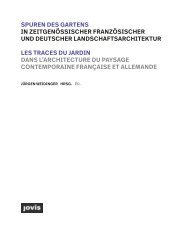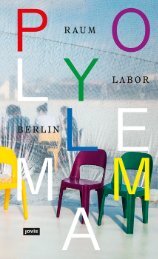Still – The East End Photographs
ISBN 978-3-86859-350-1
ISBN 978-3-86859-350-1
You also want an ePaper? Increase the reach of your titles
YUMPU automatically turns print PDFs into web optimized ePapers that Google loves.
<strong>Still</strong><br />
<strong>The</strong> <strong>East</strong> <strong>End</strong> <strong>Photographs</strong><br />
Philippe Cheng
n<br />
OthI<br />
n<br />
g can<br />
s<br />
urPas<br />
s<br />
the m<br />
y<br />
SteR<br />
y<br />
of<br />
s<br />
tilLnes<br />
s<br />
e e cummings<br />
“poem 42”<br />
from 73 poems
Long Island was originally part of the New England mainland, but over time<br />
a river formed which ran from west to east in approximately the location of<br />
the Long Island sound, which began its evolution as an island.<br />
And then, 61,000 years ago the Wisconsin Glacier advanced down<br />
New England and slowly came to a halt when it passed over the river.<br />
Poised over the center of the future Long Island, it was melting as fast as<br />
it was advancing and as it did so it rained tons of soil and stone at its<br />
front line. This pile of debris, known as the Ronkonkoma Terminal Moraine<br />
stretched from Brooklyn to Montauk in approximately the location of the Long<br />
Island Expressway. Everything south of it, known as outwash plain, became<br />
the Hempstead Plains, and, south of that, Long Island’s famous beaches.<br />
This all took about 40,000 years and then, as weather conditions changed,<br />
the glacier receded to what is now the North Fork and deposited the Harbor<br />
Hill Moraine, which stretches from Brooklyn Heights to Orient Point.<br />
<strong>The</strong> jagged edges of the glacier, and the large chunks of ice that remained<br />
behind to melt slowly in large depressions, left an intricate arrangement of<br />
ponds, bays, and convoluted shorelines.<br />
This busy relationship of land and water created the conditions that make<br />
Long Island’s amazing, unique quality of light.<br />
<strong>The</strong> light that can inspire an artist to create a work that is simply, beautifully,<br />
all about his love for this place and its light.<br />
Edwina von Gal
When asked what makes a good photograph I easily respond by summing<br />
up my prerequisites: form, content, composition. But asked what makes me fall<br />
in love with a photograph my answer is quite different. I no longer analyze.<br />
Instead, I respond to the photograph emotionally. It becomes very personal<br />
and it has as much to do with my life as it does with the photographer’s<br />
accomplishment. I look at it much as I read a poem: what I see or read<br />
resonates and transports me into its world.<br />
When I look at Philippe Cheng’s pictures collected in <strong>Still</strong>, my first response<br />
is the memory of the exquisite walks I have taken on the beaches of the <strong>East</strong><br />
<strong>End</strong> of Long Island. <strong>The</strong> light changes from day to day, morning to night, yet<br />
it is uniquely Long Island light. It comes as no surprise that painters migrated<br />
there and created masterpieces. This ever-changing light has seduced Philippe<br />
much the same way. His pictures are not only photographs of nature—they are<br />
portraits of <strong>East</strong> <strong>End</strong> light. He does it brilliantly, never repeating himself.<br />
His photographs take me to the quietest places I have visited. Walking in<br />
the dark woods of Germany was my escape during a turbulent childhood.<br />
I take a look at Philippe’s images and I immediately experience the same<br />
peace I found then.<br />
Philippe studied art history and later photography at the School of Visual Arts<br />
and New York University. However, he credits much of his visual education to<br />
Magnum Photos. He worked in its library for five years. <strong>The</strong>re he spent time<br />
with exceptional photographs and photographers he admired. All along he<br />
kept going to museums, where monochromatic painters like Agnes Martin and<br />
colorists like Milton Avery influenced his own work.
TS:<br />
PC:<br />
TS:<br />
PC:<br />
TS:<br />
PC:<br />
TS:<br />
PC:<br />
Do you do anything to alter your photographs? Do you manipulate the color or use<br />
Photoshop for composition?<br />
No. I shot the majority of the <strong>Still</strong> images on film but some in digital so I did crop.<br />
I have a square brain so when I’m photographing I’m thinking square. I’m not thinking<br />
horizontal or rectangular. I don’t manipulate the color or do anything to alter the composition<br />
on the image. I don’t want there to be any deception. <strong>The</strong> colors are what I capture with the<br />
camera in available light.<br />
To get the one right image, how many frames do you take?<br />
Sometimes it could be five frames and sometimes it could be ten. Rarely is it more than that.<br />
I might move, shift my focus plane. I might do five frames here, shift, five frames here.<br />
In the past there would be a contact sheet and I could follow my thought process. This is<br />
the challenge I think, of the digital world. When I first started making abstract color fields,<br />
I knew that’s where I was going and it felt right.<br />
You use the words, “abstract color field,” which is a movement in the world of painting.<br />
Are you influenced by or inspired by artists like Helen Frankenthaler?<br />
When I was young I saw a Milton Avery painting at the Metropolitan Museum,<br />
“Speedboats Wake,” and that image stuck with me. It was a seascape with a little tiny<br />
boat and beautiful, rich, deep blue sea. I do love Frankenthaler’s work as well as Mark<br />
Rothko, Richard Dieben korn, Richard Serra, Agnes Martin. I love color but more where<br />
the color is muted and subtle.<br />
In <strong>Still</strong> there are abstract images as well as some that are more recognizably landscapes.<br />
But none of them is necessarily identifiable as any particular place, unlike your New York<br />
pictures that are quite identifiably of the city. It seems that there has been a sea change in<br />
your aesthetic point of view since you moved to the <strong>East</strong> <strong>End</strong> of Long Island.<br />
Moving here, having a family, all of that definitely shifted my ground and has impacted<br />
how I make pictures. But this point of view has always been with me to a certain extent.<br />
Cummings was the first poet I really connected with and I always try to find a way to strive<br />
to that language and that typography and that feeling. <strong>The</strong> grittiness of the early pictures is<br />
something that is not disconnected from me. I needed to do those in order to bring me here.<br />
I come back to the word “striving” often in the sense that life is very humbling, especially<br />
when you are trying to find the right language to say what you feel. When I first came out<br />
here I photographed the landscape in a literal way, but it said nothing to me. I was struggling<br />
to find the right language and then I started changing.
Untitled, 2002<br />
Untitled, 2005<br />
Untitled, 2012<br />
Untitled, 2005<br />
Untitled, 2013<br />
Untitled, 2011<br />
Untitled, 2002<br />
Untitled, 2011<br />
Untitled, 2002<br />
Untitled, 2011<br />
Untitled, 2005<br />
Untitled, 2006<br />
Untitled, 2005<br />
Untitled, 2005<br />
Untitled, 2003<br />
Untitled, 2004<br />
Untitled, 2005<br />
Untitled, 2011<br />
Untitled, 2005<br />
Untitled, 2012<br />
Untitled, 2012<br />
Untitled, 2011<br />
Untitled, 2002<br />
Untitled, 2006<br />
Untitled, 2010
Untitled, 2011<br />
Untitled, 2005<br />
Untitled, 2008<br />
Untitled, 2006<br />
Untitled, 2011<br />
Untitled, 2005<br />
Untitled, 2008<br />
Untitled, 2011<br />
Untitled, 2011<br />
Untitled, 2013<br />
Untitled, 2011<br />
Untitled, 2010<br />
Untitled, 2011<br />
Untitled, 2010<br />
Untitled, 2011<br />
Untitled, 2008<br />
Untitled, 2011 Untitled, 2011<br />
Untitled, 2008<br />
Untitled, 2004<br />
Untitled, 2012<br />
Untitled, 2013<br />
Untitled, 2011<br />
Untitled, 2003 Untitled, 2010


















